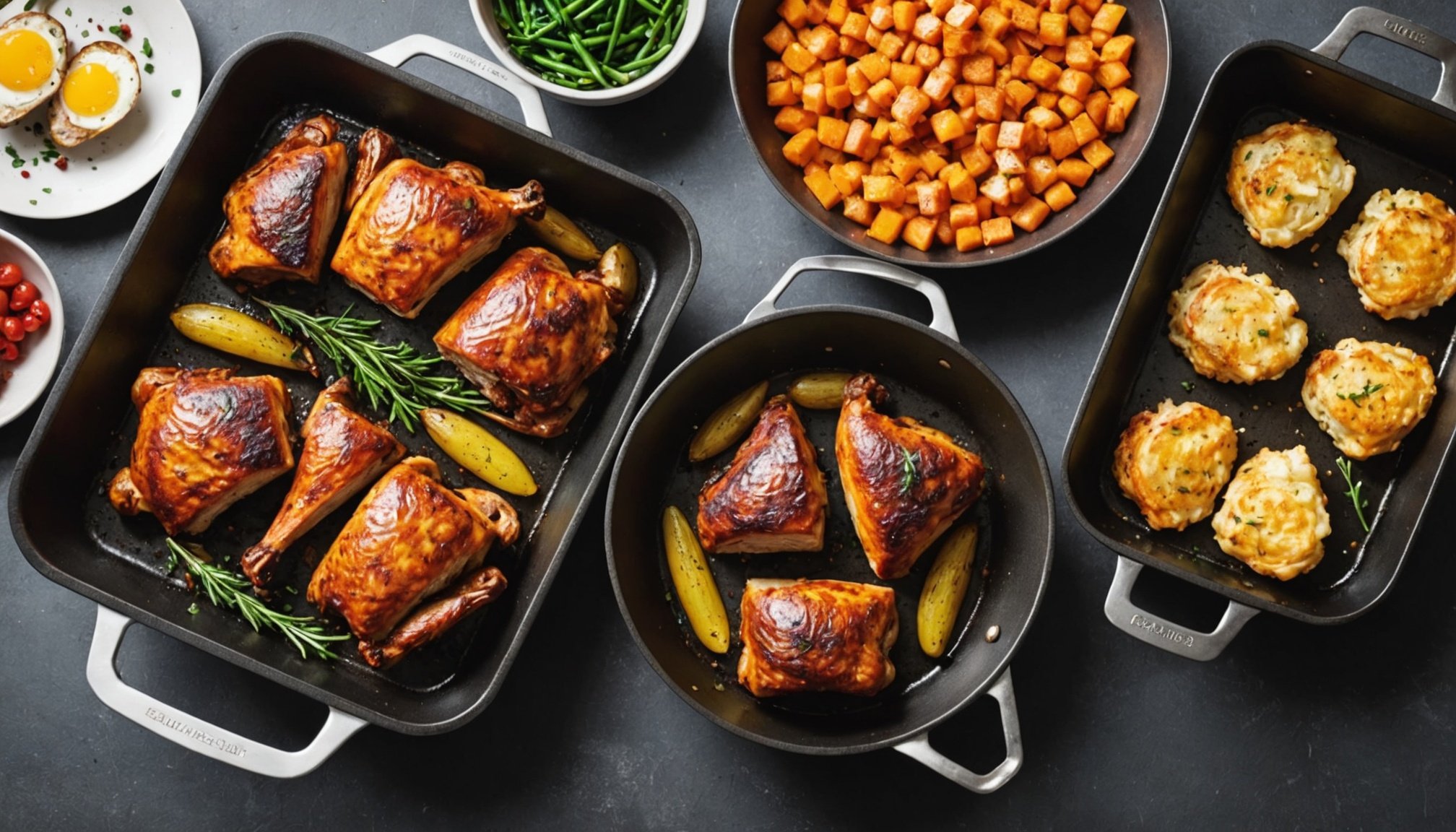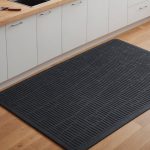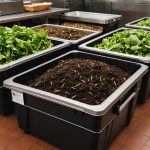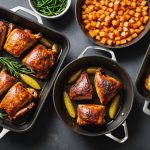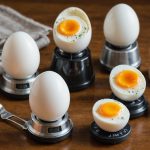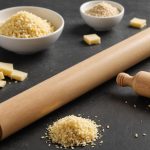Finding the right material for your roasting pans can revolutionize your cooking experience. Ultra non-stick options not only make cleanup a breeze but also enhance your culinary results. From durable ceramic to advanced metal composites, each material offers unique benefits. This guide explores the best choices available, helping you select the ideal roasting pan that fits your cooking style and needs. Elevate your kitchen game and enjoy mouthwatering meals with minimal hassle.
Overview of Ultra Non-Stick Roasting Pans
Exploring the essentials of high-performance cookware
Also read : Choosing the Ideal Egg Timer for Perfectly Cooked Soft-Boiled Eggs: A Comprehensive Guide
Definition and Purpose
Ultra non-stick roasting pans are essential tools in any kitchen, designed to ensure that food releases effortlessly, making both cooking and cleaning more efficient. Their primary purpose is to roast meats and vegetables without the need for excessive oil or fat, promoting healthier cooking methods. These pans are particularly valued for their ability to maintain even heat distribution, which is crucial for achieving perfectly cooked dishes.
Importance of Material Selection
The choice of materials in ultra non-stick roasting pans significantly influences their performance. High-quality materials enhance the non-stick properties and durability, ensuring the pans withstand high temperatures and frequent use. Material selection also affects heat conduction and retention, critical factors in achieving consistent cooking results.
In the same genre : Discover the Ideal Materials for the Perfect Non-Slip Kitchen Mat!
Common Materials Used
- Aluminum: Known for its excellent heat conduction.
- Stainless Steel: Offers durability and resistance to rust.
- Ceramic Coating: Provides a natural, chemical-free non-stick surface.
Each material brings unique benefits, allowing users to select a pan that best suits their cooking style and needs. Understanding these options encourages informed decisions, ensuring a satisfying culinary experience with ultra non-stick roasting pans.
Comparison of Materials
Diving into the specifics of roasting pan materials
Ceramic
Ceramic roasting pans offer a blend of benefits and drawbacks that are important to consider. One of the primary advantages is their natural non-stick surface, which allows for healthier cooking with minimal oil. Additionally, ceramic provides excellent heat distribution, ensuring even cooking performance.
However, there are drawbacks, such as their susceptibility to chipping and cracking if not handled carefully. Despite this, ceramic is considered safe and free from harmful chemicals like PFOA and PTFE, making it a health-conscious choice for many.
-
Benefits:
-
Natural non-stick surface
-
Excellent heat distribution
-
Chemical-free
-
Drawbacks:
-
Prone to chipping
-
Requires careful handling
In terms of safety and health considerations, ceramic pans are often preferred due to their inert nature, which doesn't react with food. This makes them an attractive option for those prioritizing health and safety in their cooking.
In summary, while ceramic roasting pans offer excellent cooking performance and safety, they demand careful use to maintain their longevity. Understanding these factors helps users make informed decisions about their cookware choices.
Benefits of Ultra Non-Stick Roasting Pans
Exploring the advantages of modern cookware
Ease of Cooking and Food Release
Ultra non-stick roasting pans revolutionize the cooking experience by ensuring that food releases effortlessly. This feature eliminates the frustration of food sticking to the pan, which is a common issue with traditional cookware. The non-stick surface is particularly beneficial for delicate foods like fish or pancakes, which require gentle handling.
Reduced Need for Oils and Fats
A significant advantage of these pans is the reduced need for oils and fats. This not only promotes healthier cooking by lowering calorie intake but also enhances the natural flavors of the ingredients. By minimizing the use of additional fats, ultra non-stick pans support a more health-conscious lifestyle without compromising on taste.
Simplified Cleaning Process
The simplified cleaning process is another compelling benefit. With food residues easily wiped away, there's no need for vigorous scrubbing or soaking. This convenience saves time and effort, making ultra non-stick roasting pans an ideal choice for busy individuals.
- Key Benefits:
- Effortless food release
- Healthier cooking with less oil
- Easy cleaning and maintenance
By understanding these benefits, users can make informed decisions about incorporating ultra non-stick roasting pans into their kitchen arsenal.
Performance Insights
Examining the efficiency and effectiveness of roasting pans
Heat Retention and Even Cooking
The performance of a roasting pan is significantly influenced by its ability to retain heat and ensure even cooking. Heat retention is crucial as it allows the pan to maintain a consistent temperature, which is essential for roasting meats and vegetables to perfection. Even cooking is achieved when the pan distributes heat uniformly, preventing hot spots that can lead to unevenly cooked dishes.
Impact on Roasting Techniques and Results
The performance of a roasting pan directly impacts roasting techniques and results. A pan with excellent heat retention allows for precise temperature control, crucial for techniques like slow roasting or searing. Even cooking ensures that every part of the dish is cooked to the desired level, enhancing flavor and texture.
- Key Performance Factors:
- Consistent temperature maintenance
- Uniform heat distribution
- Enhanced flavor and texture
User Experiences and Expert Reviews
User experiences and expert reviews often highlight the performance of roasting pans in real-world scenarios. Many users appreciate how effective heat retention and even cooking lead to superior results. Experts frequently recommend pans that excel in these areas, emphasizing their importance in achieving professional-quality dishes. Understanding these insights can guide users in selecting the best roasting pan for their needs.
Maintenance Tips
Ensuring longevity and performance of your roasting pan
Recommended Cleaning Methods
Proper roasting pan maintenance is crucial for preserving its functionality and appearance. For aluminum pans, gentle hand washing with mild detergent is recommended to avoid damaging the surface. Stainless steel pans can be cleaned with a mixture of vinegar and baking soda to remove stubborn stains. Ceramic pans should be soaked in warm water before gently scrubbing to prevent chipping.
Tips for Preserving Non-Stick Surfaces
To extend the life of the non-stick surface, avoid using metal utensils which can cause scratches. Instead, opt for wooden or silicone tools. Additionally, refrain from using abrasive cleaners that can wear down the coating. Always allow the pan to cool before washing to prevent warping and maintain its non-stick properties.
Common Pitfalls to Avoid
Avoid placing roasting pans in the dishwasher unless explicitly stated by the manufacturer, as this can degrade the material. Do not use high heat settings unnecessarily, as excessive heat can damage the non-stick surface.
- Key Tips:
- Use gentle cleaning agents
- Avoid metal utensils
- Allow pan to cool before cleaning
By following these maintenance tips, you can ensure your roasting pan remains in excellent condition, providing reliable performance for years to come.
Health Considerations
Exploring the intersection of health and safety in cooking
Safety of Non-Stick Coatings
Non-stick coatings in roasting pans are designed to enhance cooking efficiency and ease. However, concerns about chemical leaching have arisen, particularly with older coatings containing PFOA or PTFE. Modern non-stick coatings often prioritize safety by being free from these chemicals, thus reducing potential health risks.
Concerns Regarding Chemical Leaching
Chemical leaching occurs when substances from the pan's surface migrate into food, especially at high temperatures. While non-stick coatings are generally safe under normal cooking conditions, it's crucial to use them correctly. Avoid overheating and using metal utensils, as these actions can damage the coating and increase the risk of chemical leaching.
Recommendations for Safe Usage
To ensure safe use of non-stick coatings, adhere to the following practices:
- Maintain moderate cooking temperatures to prevent degradation.
- Utilize wooden or silicone utensils to avoid scratches.
- Regularly inspect the pan's surface for signs of wear.
These strategies help minimize the risk of chemical leaching and maintain the integrity of non-stick coatings. By following these guidelines, users can enjoy the benefits of modern cookware while prioritizing health and safety in their culinary endeavors.
Top Product Recommendations
Identifying the best ultra non-stick roasting pans
Criteria for Selecting Quality Roasting Pans
Choosing the best ultra non-stick roasting pans involves evaluating several key factors. Consider the material for its heat conduction and durability, and ensure it supports the non-stick feature. Heat retention and distribution are crucial for even cooking, while the pan's ability to withstand high temperatures without warping is essential for longevity.
Overview of Top-Rated Products
Several top-rated ultra non-stick roasting pans have emerged as favorites among consumers. These include models with ceramic coatings for their chemical-free properties, and stainless steel options for their robust construction. Each product offers unique benefits, catering to different cooking styles and preferences.
- Top Picks:
- Ceramic-coated pans for health-conscious users
- Stainless steel pans for durability
- Aluminum pans for superior heat conduction
Price Range and Value Analysis
The price of ultra non-stick roasting pans varies widely, reflecting differences in materials and features. Entry-level models may start around $30, while premium options can exceed $100. Assessing the value involves comparing the durability and performance benefits against the cost. Investing in a higher-priced pan often offers long-term savings due to its extended lifespan and enhanced cooking results.
Practical Roasting Techniques
Mastering the art of roasting for culinary excellence
Tips for Achieving Perfect Roasts
Achieving a perfect roast requires attention to several key roasting techniques. Begin by selecting the right roasting pan to ensure even heat distribution. Preheating the oven is crucial for consistent results, allowing the pan to reach the desired temperature before placing the food inside. This step prevents uneven cooking and enhances flavor.
Importance of Preheating and Oven Settings
Proper oven settings are essential in roasting techniques. Use a thermometer to verify the oven's accuracy, as incorrect temperatures can affect the texture and taste of your roast. Preheating ensures the roasting pan is hot enough to sear the food, locking in juices and creating a crispy exterior. Adjusting the oven rack position can also impact cooking, with the middle rack often providing the best results.
Creative Uses for Roasting Pans Beyond Traditional Roasting
A roasting pan is versatile beyond traditional uses. It can serve as a base for baking casseroles or roasting vegetables. Consider using it to prepare one-pan meals, combining proteins and vegetables for easy cleanup.
- Creative Uses:
- Baking casseroles
- Roasting vegetables
- One-pan meals
These roasting techniques enhance your cooking repertoire, making the most of your kitchen tools.
User Reviews and Expert Opinions
Exploring insights from consumers and professionals
Summary of Consumer Feedback
Consumer feedback on roasting pans often highlights the importance of non-stick performance and durability. Many users appreciate how these features simplify cooking and cleaning, aligning with their busy lifestyles. A common trend in reviews is the preference for ceramic coatings, praised for their chemical-free properties and even cooking results.
Analysis of Expert Evaluations
Experts frequently evaluate roasting pans based on heat retention and material quality. Their assessments often emphasize the benefits of stainless steel for its robustness and aluminum for superior heat conduction. Experts also recommend models with strong non-stick capabilities, ensuring a seamless cooking experience.
Trends in User Preferences and Market Performance
Recent trends indicate a growing demand for health-conscious options, with consumers prioritizing chemical-free coatings. The market has responded by offering a wider range of ceramic and stainless steel pans.
- Consumer Preferences:
- Chemical-free coatings
- Durable materials
- Effective non-stick performance
These insights into roasting pan reviews reveal a shift towards products that combine functionality with health benefits, reflecting evolving consumer priorities. Understanding these trends helps users make informed decisions, ensuring they select roasting pans that best meet their needs.
Conclusion and Final Thoughts
Reflecting on the journey with ultra non-stick roasting pans
Recap of Key Findings
Non-stick roasting pans have proven to be invaluable in modern kitchens, offering effortless food release and promoting healthier cooking with less oil. Their ability to maintain even heat distribution ensures perfectly cooked meals, enhancing both flavor and texture. The choice of materials, such as ceramic, stainless steel, and aluminum, plays a crucial role in performance and user satisfaction.
Encouragement to Make Informed Choices
When selecting a non-stick roasting pan, consider the specific benefits each material offers. Ceramic is ideal for those seeking chemical-free options, while stainless steel provides durability. Aluminum excels in heat conduction. Evaluating these factors will help you make informed choices aligned with your cooking style and health priorities.
Final Tips for Successful Roasting Experiences
To maximize your roasting experiences, remember these tips:
- Preheat the oven to ensure even cooking.
- Use wooden or silicone utensils to preserve the non-stick surface.
- Avoid high heat settings to maintain the pan's integrity.
These strategies will help you achieve culinary excellence with your non-stick roasting pan, ensuring delightful results every time. By understanding and applying these insights, you can confidently explore the world of ultra non-stick roasting pans and enjoy their numerous benefits.

